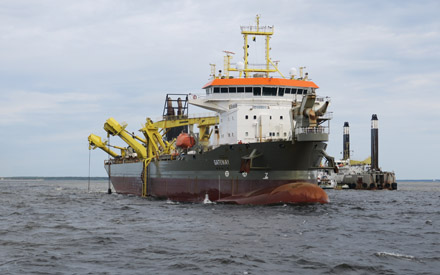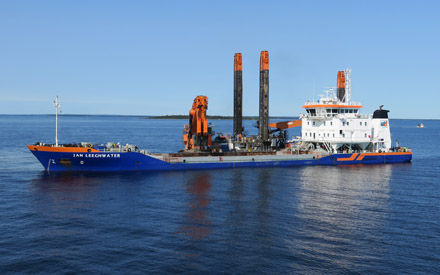
The Magnor dredging in Sandgrönnleden
This project, of which the realisation will cover the next five years, takes place in the port of Luleå and its access channels.
Four organisations have joined forces in a partnership for what has been named Project Malmporten. These are the Port of Luleå (Luleå Hamn AB). the National Maritime Administration (Sjöfartsverket), the Swedish Transport Administration and the Municipality of Luleå.
Luleå Hamn and Sjöfartsverket are both responsible for the actual realisation of this project, consisting of contracting the dredging and related maritime construction works, while Sjöfartsverket will also take care of updating the fairway buoyage.
The Project Malporten can be divided into five different components.
In addition to these parts of the project, there is also some additional dredging work to carry out some 200 km south of Luleå.
This has to do with a shallow area in the Baltic Sea known as the Kvarken, roughly located between Umeå and Vaasa in Finland.
In order to make the northern part of the Baltic Sea, i.e. the Gulf of Bothnia, accessible for ships with a draught of 15 meters, known as "Östersjömax", dredging activities are needed here too.
Since such an operation will not only benefit the port of Luleå, but also several Finnish ports, this operation will be carried out under the responsibility of both Sjöfartsverket and the Finnish Transport Infrastructure Agency.
In the port area of Luleå and the nearby section of Sandöleden also dredging activities have to be carried out as part of this contract.
The works of this contract have been completed before this winter's ice season.
Sources:
The first two involve deepening the two access channels to the port.
In fact, the port of Luleå has both a summer and winter access channel, known as Sandöleden and Sandgrönnleden respectively.
The first one provides more direct access to the open water of the Baltic Sea, whereas the second one is more suitable to be used in winter time when the fairways are covered by ice.
In fact, Sandgrönnleden follows a more sheltered route making it easier to keep it open with the help of icebreakers.
The summer fairway, Sandöleden, will be dredged from its current depth of 11.60 meters to 16.85 meters, while Sandgrönnleden will be deepened with 5.60 metres, i.e. from 9.60 to 15.20.
The dredging in both channels fall under the responsibility of Sjöfartsverket.
Luleå Hamn on the other hand takes on the remaining three components, which all take place in the port area known as Skvampen.
Here reclamation of new land, construction of a new quay wall and dredging of a new deep harbor, with a depth of 16.85 meters, will be carried out.

The Gateway dredging in Sandgrönnleden
With the Malmporten project, the port of Luleå will be able to handle vessels three times as large compared to the current situation.
Instead of the current maximum of 50,000 tonnes, after the completion of the project, the port will be accessible for vessels up to 160,000 tonnes in cargo capacity.
The port of Luleå is known to be vital for steel related activities.
Approx. 200 km to the north, are located two of Europe’s major iron ore mines, respectively in Gällivare and Kiruna.
From these mines, the iron ore is transported by rail to Luleå.
In the port area there are several steel related plants that handle the first stages of refining and currently pelleted ore, fines and steel slabs are being exported.
However, there are plans to expand the steel-related activities and in the future steel coils will also be exported and steel scrap will be imported for the production of new steel.
Also, energy sources for the steel plants are being imported, at present this is mainly coal, but in the future a shift to more sustainable energy sources is expected.
With the European Union's aim of becoming less dependent on sources outside the Union for its raw materials, the Swedish iron ore mines will play an important role, and the increase in handling capacity at the port of Luleå is seen as an important step in this direction.

The Simson loading the split hopper Jan Leeghwater
The dredging activities that have recently started are part of a contract that covers the first stage of the project, representing about 10% of the total.
After a tender, this contract has been awarded to a joint venture of Boskalis and Van Oord.
Two main dredging activities are comprised in this contract.
At first, a section of the Sandgrönnleden at about 15 kilometres offshore from the port of Luleå has to be dredged to the required depth.
Due to the difficult soil conditions, i.e. the seabed is of moraine origin and consists of material that has been heavily compacted during the ice ages and is mixed with numerous boulders, the equipment that is ideally suitable for this part consists of backhoe dredgers.
It may be no surprise that Boskalis and Van Oord have mobilised their most powerful dredgers of this type for this work, respectively the Magnor and the Simson, both with a total installed power of approx. 4,100 kW.
These dredgers are supported by the 12,000 m3 trailing suction hopper dredger Gateway that takes mostly care of the top layer suitable for suction dredging.
This part of the contract represents some 800,000 m3 of material to be dredged.
This represents approx. 700,000 m3 of material.
Part of this is needed to create an underwater pit to store contaminated material from the port that is scheduled to be dredged in a future stage.
This will be included in a next contract, which will also include the final capping with clean material.
For the work under the current contract, Boskalis and Van Oord have deployed the grab dredger Kahmari 2 from Boskalis Terramare and the backhoe dredger Optimus, which has been chartered from the Finnish company Wasa Dredging.
In the meantime, contract preparation is underway for the next stages of this enormous project.
To give an idea, including the current contract, the total project comprises roughly 21 million m3 of dredging work and drilling and blasting of 1 million m3 of rock.
The dredging works are expected to be completed in 2028 and the new deep harbor in Skvampen is planned to be operational in 2029.
- Malmporten project
- Sjöfartsverket